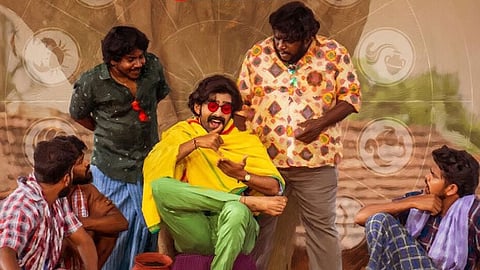Kothapallilo Okappudu Movie Review: An exuberant satire that explores bold ideas
Kothapallilo Okappudu(3.5 / 5)
The world of Kothapallilo Okappudu is filled with many colourful characters, but leading the pack is Ramakrishna, the lovable underdog protagonist whose quest to find a recording dance performer is both amusing and endearing. However, something happens a little before the interval mark that turns the tables on our sympathies for this underdog. At a moment of crisis when evil has struck again, and you can see fright on everyone’s faces, Ramakrishna (Manoj Chandra in an impressive debut) can be seen smiling, for, at that point, nothing else matters to him except for fulfilment of his own motives. And you realise Ramakrishna, our hero, is not so heroic after all. We are still on this journey, but now more curious than sympathetic, more intrigued than emotionally tied.
Cast: Manoj Chandra, Usha Bonela, Ravindra Vijay, Monika T, Banerjee,
Director: Praveena Paruchuri
Kothapallilo Okappudu, which also marks Praveena Paruchuri’s directorial debut, begins with an Anais Nin quote, ‘We don't see things as they are; we see them as we are.’ Yet, Praveena makes it clear in many ways that we would be wrong to see this as another C/O Kancharapalem. For an endearing film about a village, this universe doesn’t have as many lovable figures. It’s a slice-of-life narrative, yes, but the slices are not necessarily sweet. The humour is never imposed upon the viewer. The caste dynamics within the village are explicitly laid out. If Reddy (Banerjee registering a towering presence) remains a casteist rice mill owner, afraid of losing all his power someday, he is projected exactly like one. This coterie of fallible figures includes Savitri, the archetypal girl-next-door and hero’s muse, who is nonetheless prone to jealousy when she sees herself losing something she never wanted in the first place. Savitri may call Adhilakshmi (Usha Bonela) her friend, but are there any societal rules to their bonding as well?
And above all is the classic evil man Appanna (played by the excellent Ravindra Vijay). There is something so slimy and unnerving about Appanna’s presence in the village, and Ravindra nails it to a tee, bringing in many little nuances that add to Appanna’s aura. In a chilling moment of exercising power dynamics, Praveena slowly reveals Appanna sleeping at a place he shouldn’t be. And yet, later on, there is a brief moment where you can see the generational baggage Appanna carries underneath all the evil. Everyone is some shade of grey.
Praveena Paruchuri captures these shades with a lot of exuberance and cinematic fervour, embellishing the narrative with many loving details. The cinematography (by Petros Antoniadis) is excellent, both in its vivid colours and frames. There are multiple two-shot scenes (many of them done in a single take) where both characters can be seen at once, to-and-fro in their banter. This framing style lends the narrative an overview-like perspective; it’s like there is nothing you are missing out on, every frame is complete within itself. The dialogues have a rustic, almost blunt flavour (including a few startling rape jokes). Many sequences don’t have background music. There is a permeating silence, and the director trusts the mood to linger and for the emotion to sear through regardless. Even the classical ‘budding romance’ song is unconventionally designed with brief flashback visuals, giving us a peek into the shared past between Savitri and Ramakrishna.
In one of the most infectious sequences of the film, Adhilakshmi aka Andham (debutant Usha Bonela in a remarkable performance) teaches Savitri a few dance moves for a stage act that may or may not materialise. It’s hard to put into words what Praveena achieves here, but at that point, Adhi rises above all ‘heroine’s friend’ stereotypes. Here, in these open fields, Andham is a young woman living her life to the fullest, away from all the biases and baggage and jokes about her appearance. I couldn’t stop smiling for that entire 3-minute stretch.
However, underneath all the charm and eccentricities is a deeper, more philosophical query about belief, and the film is anything but subtle about it. Unfortunately, this is where the narrative falters a bit, as it realises it has too many elements on the platter. The struggle to neatly tie them all begins to show after a point. As opposed to the earlier portions where the socio-political commentary was subdued yet effective, the film becomes more verbose in these portions, blunting the impact of some of its hilariously satirical moments in the second half as Ramakrishna struggles to destroy the one thing everyone is keen on worshipping. The discord between text and tonality becomes apparent in these portions, as the film juggles comedy and commentary.
And yet, there’s something very admirable about how Kothapallilo Okappudu explores these themes. It’s a very bold move to nudge us on the power of belief, especially in current socio-political climate, without making it about a specific religion or taking an overt stand. The narrative clings heavily to the word ‘Namakkam.’ Belief, a phenomenon that goes beyond facts and reality. After a point, it isn’t important if something is founded in science or rationale. What matters is what you choose to believe, what gives you strength, and what unites you as a collective whole. If a superstitious belief gives you the drive to pull through life, so be it. Remember, this is a village where a police constable works as a priest. Or is it a priest working as a policeman? Who knows? After all, we don't see things as they are; we see them as we are.


